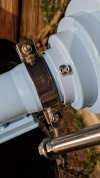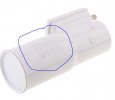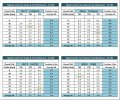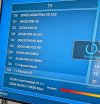a33
Specialised Contributor
- Joined
- Sep 24, 2009
- Messages
- 1,327
- Reaction score
- 755
- Points
- 113
- Age
- 64
- My Satellite Setup
-
XSAT410
Rebox RE-9000
- My Location
- The Netherlands
as soon as the weather improves (today I have a very cold fog) I will take some pictures to show how my actuator is set.
I made a solid clamp to let the actuator move away from the polar axis when it goes east (the cylinder is on the west side)
when the actuator is fully retracted (west) it is perpendicular to the south
with actuator like this the parabola sweeps faster to the east than to the west for the same actuator travel
a very good solution here !! but more complex !!
I looked a bit more into the actuator mount, as in the picture. It is interesting.
As long as B+C = A, the big advantage seems to be the the reduced risk of flopping the dish, by generating a theoretical >180 degree rotation range, similar to here: 180 Degree Rotation with Linear Actuator | Home CSP, Inc.
The bigger C is, the more the risk of flopping is reduced.
The range of higher accuracy then also shifts a bit to the extended side of the actuator, but it would do that even more when A > B+C , if I'm not mistaken. So no need to stick to A=B+C with this setup, I would say: length A could be longer.
Another effect (advantage) of spreading the accuracy more towards the extended side of the actuator would be, that at the extended side less motor power is needed for retracting the dish again, as the actuator can take a longer length for retracting a rotational degree.
I've read that some people had trouble with retracting because of the the dish weight, but I did not read this approach.
NB In setups where C is small, the maximum (theoretical) actuator stroke length for the setup is never more than 2B (when B<A), or 2A (when A<B ); so maximum twice the shortest triangle side length, as we called it earlier in this thread.
When C is greater, as in this case, the maximum (theoretical) actuator stroke length for the setup increases to 2B + C when (A = B+C), or even to A+B when (A > B+C).
Knowing the maximum possible stroke length for the actuator, could help designing the proportions of the triangle side lengths.
Added: For instance: increasing the already longer leg of the triangle sides, does not imply that the actuator stroke becomes larger. That is not mentioned very often.....
I hope that I've described this somewhat understandable.
It does look like till now, this is a bit under-developed area in our satellite dish hobby....
Greetz,
A33
Last edited:













